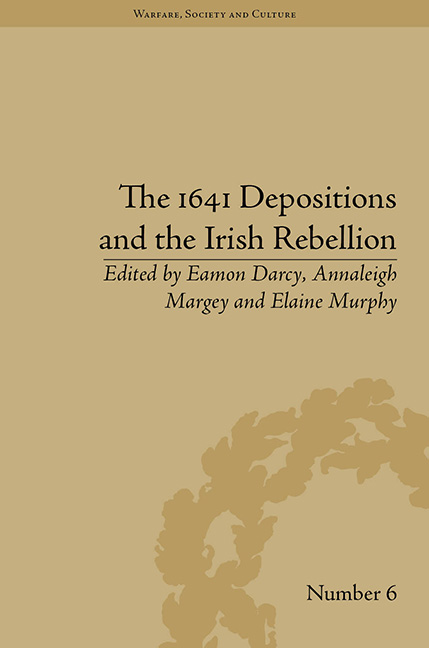Book contents
- Frontmatter
- CONTENTS
- Dedication
- Acknowledgements
- List of Contributors
- List of Figures and Tables
- List of Abbreviations
- Preface
- Introduction
- Part I The Outbreak of the Rebellion
- Part II Social Aspects of the Rebellion
- 5 ‘In Monies and Other Requisites’: The 1641 Depositions and the Social Role of Credit in Early Seventeenth-Century Ireland
- 6 1641 and the Ulster Plantation Towns
- 7 The Social Order of the 1641 Rebellion
- 8 ‘Rogues, Villaines & Base Trulls’: Constructing the ‘Other’ in the 1641 Depositions
- Part III Political and Military Aspects of the Rebellion
- Conclusion: The Rebellion in Text and Context
- Notes
- Index
6 - 1641 and the Ulster Plantation Towns
from Part II - Social Aspects of the Rebellion
- Frontmatter
- CONTENTS
- Dedication
- Acknowledgements
- List of Contributors
- List of Figures and Tables
- List of Abbreviations
- Preface
- Introduction
- Part I The Outbreak of the Rebellion
- Part II Social Aspects of the Rebellion
- 5 ‘In Monies and Other Requisites’: The 1641 Depositions and the Social Role of Credit in Early Seventeenth-Century Ireland
- 6 1641 and the Ulster Plantation Towns
- 7 The Social Order of the 1641 Rebellion
- 8 ‘Rogues, Villaines & Base Trulls’: Constructing the ‘Other’ in the 1641 Depositions
- Part III Political and Military Aspects of the Rebellion
- Conclusion: The Rebellion in Text and Context
- Notes
- Index
Summary
The foundation of a wide variety of towns and villages across many regions in Ireland from the mid-sixteenth century onwards is symbolic of … dramatic social, cultural and economic changes. The English administrators and settlers sought to turn Irish space into another England.
In his study of the historical geography of early modern Ireland, William J. Smyth recognized the central role of towns and villages in the transformation of the cultural and social landscape of Ireland during British settlement in the sixteenth and seventeenth centuries. The changes wrought by these urban settlements can be observed most acutely in Ulster where, from the early seventeenth century, officials made preparations for a plantation. Towns and villages became a core feature of the conditions for plantation, with twenty-five corporate towns proposed in the plan. The plantation conditions also instructed undertakers of the largest estates to encourage clustered village settlement on their lands. These towns and villages had a dramatic effect on the social and cultural landscape of the province, with the emergence of an urban network built and governed in the same fashion as early modern towns in England.
By 1641, Ulster had a significant urban geography with sixteen of the twenty-five towns proposed under the plantation fully incorporated, and large numbers of towns and villages scattered across the plantation network as a whole. In County Donegal, for example, four towns – Ballyshannon, Donegal, Killybegs and Lifford – had received their charters, while significant market towns had developed at Letterkenny and Raphoe. While County Donegal is geographically a large area, the emergence of such a large town network from the north to the south suggests just how significant the urban spread was in Ulster in the aftermath of plantation.
It is not surprising, therefore, that at the outbreak of rebellion in October 1641, these towns became the focus of rebel attacks. Towns and fortified settlements such as Dungannon, Charlemont, Mountjoy, Cookstown, Moneymore and Dungiven were among the first locations to fall into rebel hands in Ulster.
- Type
- Chapter
- Information
- The 1641 Depositions and the Irish Rebellion , pp. 79 - 96Publisher: Pickering & ChattoFirst published in: 2014

